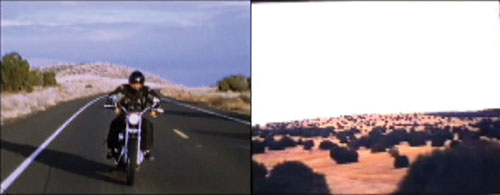Amy Granat and Drew Heitzler, Stills from T.S.O.Y.W., 2007.
Amy Granat: Born 1976 in Saint Louis, Missouri; lives in New York, New York. Drew Heitzler: Born 1972 in Charleston, South Carolina; lives in Los Angeles, California
For their first film collaboration, Amy Granat and Drew Heitzler bring unique aesthetic contributions to T.S.O.Y.W. (2007). Amy Granat works with film stock as raw material to make abstract films and photograms that are minimal and site specific. Though some of Drew Heitzler’s films, such as Subway Sessions (2002), have employed traditional narrative, his films more often operate within the context of installations. In his 2007 exhibition at Los Angeles’s Trudi Gallery, Heitzler showed Untitled (Ladera Heights) (2007), a short, silent black-and-white film of a single image of a Los Angeles oil dike interrupted by a color shot of palm trees; concurrently, a few miles away at Angstrom Gallery, he laid stills of every third frame (two hundred in all) from the film on the gallery’s floor. This gestural, tangible approach to manipulating film stock is the common ground underlying Granat and Heitzler’s recent team effort.
T.S.O.Y.W., whose protagonist derives from Johann Wolfgang von Goethe’s Werther, developed from Granat and Heitzler’s discussions with artists Olivier Mosset and Steven Parrino about writer Jean Genet’s suggestion in his autobiography of replacing Werther’s unattainable love, Charlotte, with a motorcycle. Presented as a dual screen projection, this film concurrently features each artist’s rendition of this idea, based on 16-millimeter footage they shot simultaneously on shared sets with Bolex cameras. A pining Werther, portrayed by artist Skylar Haskard, searches in vain for meaning in his desert home, eventually enacting the quintessential American road trip. After stealing his friend’s Harley from his Airstream trailer, Werther rides it to Robert Smithson’s Spiral Jetty and Joshua Tree. On what Heitzler calls Werther’s “journey to nowhere,” he finally wanders away into the distance, mirroring the lost temporality and melancholic feeling noted by the artists in both Goethe’s epistolary novel and in America’s current wartime malaise. A subtle political statement, the film functions metaphorically as what Heitzler calls a “romanticized death.”
Structurally, Granat has made her most narrative film to date, editing in-camera to tell Werther’s story through varying light and scene length. While filming, she explored numerous effects, such as changing aperture to achieve a strobelike vibration in certain sequences. Heitzler’s wide-angle shots flatten out the already flat desert horizon, and his exploitation of the telephoto lens lends his edit a grainy nostalgia. A soundtrack composed by Granat and artist Jutta Koether adds discordant sonic ambience to the film’s sense of emotional disconnect. In this portrait of a modern-day Werther, the only consolation that remains is the symbolic freedom of the open road. TRINIE DALTON
Amy Granat and Drew Heitzler, Stills from T.S.O.Y.W., 2007. Two-channel projection, 16mm film transferred to digital video, color, sound; 200 min. Collection of the artists.

























